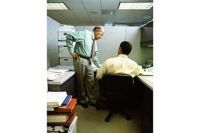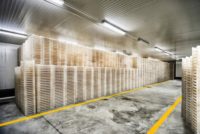Meat and poultry processors that underestimate the importance of investing in state-of-the-art chilling and freezing technologies and systems are set to feel the cold.
To maximize product revenues, it is essential for plant technologies to sustain food quality while helping to reduce shrink and food safety risks. Achieving such objectives, though, is becoming increasingly difficult as many operators are forced to handle larger carcasses with inadequate tools and techniques, analysts say.
“Because cattle is getting bigger and bigger, it is a major undertaking to chill the animals properly without making huge capital investments in equipment, including hot boxes and chilling systems,” says Keith Belk, a professor in the Department of Animal Sciences and the Center for Meat Safety and Quality at Colorado State University, in Fort Collins. “Six hundred- to 700-pound beef carcasses were considered big in the 1980s, but now there are routinely 1,200- and 1,300-pound carcasses in coolers, and both cattle and pigs have almost doubled in size.”
Contributing to the problem is limited space in production lines. This in many instances leads to carcass overcrowding, he says.
“Carcasses that push against each other immediately following harvesting won’t chill properly as they maintain heat within muscle tissues,” Belk says. “Chilling and cooling never improves meat and poultry quality, but only can reduce quality when not done correctly.”
In addition, while operators typically spray carcasses with cold water at controlled on-off intervals during the first eight hours of chilling, there often is not enough clearance between oversized animals to treat the entire carcass surface, which prevents heat dissipation and affects product integrity, he says.
The likelihood of health risks also increases when chemical sprays do not reach all areas of a carcass during processing, Belk says.
A further consequence of bigger carcasses is the inability to routinely freeze all tissues in a timely manner, resulting in the formation of ice crystals within muscle cells that can diminish the appearance and result in purge during packaging, he says, adding that variety meats, such as livers and tendons, also are often too large to be properly treated in current chilling and freezing systems.
While processors can enhance operations by updating their slaughter systems and chilling and freezing technologies, Belk says such initiatives are “tough and expensive. We are talking tens to hundreds of millions of dollars along with associated sustainability and power issues.”
Speed is of the essence
Analysts say the most efficient procedures enable operators to rapidly chill and freeze meat and poultry after harvesting.
It is essential to quickly reduce meat temperature from the initial body temperature to approximately 33 degrees Fahrenheit to retard the growth of microorganisms while maintaining color and enhancing product shelf lives, says Wendell Marshall, principal with Creston, British Columbia-based Strong Refrigeration Consultants.
Processors can better meet those objective by placing carcasses in coolers and circulating air at the target temperature, which has a drying effect, he says.
A common method for cooling poultry is to bathe birds in chilled water, which helps minimize shrink but results in challenges for controlling bacteria, Marshall says. Using an air chill system that transports birds through controlled temperature zones on a continuous moving rail typically results in acceptable shrink levels and longer product shelf lives, he says.
An effective system for freezing portioned meat selections, meanwhile, is Individually Quick Freezing (IQF), Marshall says, which features a spiral freezer or in-line belt freezer. As part of the procedure, operators place products on moving belts and force cold air around the items in the freezer area, Marshall says.
Processors also can batch freeze, a system in which users place boxed products in a freezer and have air circulate around the selections, he says, noting the method has a lower initial cost than IQF but is slower and more labor intensive.
In addition, Marshall says, “freezing raw, uncooked product will result in significant weight loss unless the product is packaged or sealed.”
Regardless of the technology, it is essential for producers to focus on reducing weight loss, or shrink, when cooling, with a target of 2 percent or less reduction of the total carcass weight for beef and pork. He adds that spraying water over beef and pork carcasses will help prevent weight declines.
“A decrease in weight during cooling results in a huge difference to producers’ bottom lines,” Marshall says, citing for example that a beef plant processing 1,000 head per day at 600 pounds per head will lose 6,000 pounds of marketable product daily for every 1 percent of shrink.
Systems also should enable users to freeze products quickly and uniformly while avoiding freezer burn and drying out surfaces in order to maintain quality and reduce bacterial growth, he says.
The take on technologies
Leveraging the most effective tools for optimal operations also involves having appropriate refrigerants, Marshall says, adding that selections are rapidly evolving.
For example, a greater market focus on ozone depletion and global warming is forcing suppliers of chlorofluorocarbons (CFC) — which contain carbon, chlorine and fluorine and hydrochlorofluorocarbons, such as the Freon brand — to phase out many products and offer alternate options.
“Natural refrigerants, such as ammonia or carbon dioxide, is now the preferred choice for many larger meat producers, he says.
Liquid carbon dioxide and liquid nitrogen are among the most effective cryogenic selections for combating product deterioration and microbial growth, says Norman Marriott, emeritus professor in the College of Agriculture and Life Sciences at Virginia Polytech Institute and State University (Virginia Tech), in Blacksburg.
“Cryogenic options are attractive because they freeze quickly, thus the ice crystals that form on meats are essentially microscopic, which makes it look like a product hasn’t been frozen,” he says. In contrast, the larger ice crystals that often appear on meat and poultry in traditional freezes can tear tissue and muscle fibers and cause water loss within the muscle, degrading a product’s appearance and quality, Marriott says.
The use of cryogenics along with new-generation chilling and freezing equipment, however, can be pricey, ranging from several thousand to more than a million dollars, depending on the size of the operation, he says.
“That is the downside,” Marriott says. “The upside is that it is the best way to freeze the product from a food safety and value standpoint.”
Dealing with the large costs of buying, installing and operating the proper refrigeration equipment is a major hurdle facing meat and poultry processors looking for the most effective and efficient systems while also meeting regulatory guidelines governing chilling times and temperatures, says Jonathan Campbell, extension meat specialist and assistant professor of animal science in the Department of Animal Science at Penn State University, in University Park.
Help is on the way
To leverage the best options, it is important for processors to thoroughly research refrigeration systems before investing in equipment. This process can include having heating, ventilation and air conditioning (HVAC) and processing engineers determine the physical demands a plant will place on chilling and freezing technologies during production, he says.
“Processors that operate in very warm and humid environments, or who underestimate the load on the refrigeration technology, may have units that will not perform as expected,” Campbell says. “The operators need to work with the HVAC companies and personnel who stay current on food industry technologies, or who have been working with food companies to design systems that fit their individual needs. Users have to prepare for the worst-case scenarios when implementing systems.”
In addition, processors should incorporate chilling and freezing equipment that can operate at peak performance over the long term, particularly if processing volumes increase, says Jeff Sindelar, associate professor and extension meat specialist in the Department of Animal Sciences at the University of Wisconsin, in Madison.
“Machinery can be very expensive and difficult to maintain as operations are hard on equipment,” he says. “But it is important to focus on the upkeep. Technologies that start losing cooling capacity or the ability to chill carcasses quickly can result in small, but often significant, changes to meat quality.”
While some producers may readily accept a 10 percent efficiency decline to save on equipment maintenance expenses, if unchecked such skimping can subtly lead to further efficiency erosions, Sindelar says.
While implementing the most appropriate system for chilling and freezing is challenging and typically expensive, it is imperative for operators to continually invest in their technologies if they are to maximize sales activity while reducing food safety threats and shrink, analysts say.
“Carcasses will keep getting bigger because of the economic incentives to producers,” Belk says. “Other than developing smaller animals or preventing the animals from getting larger, the main alternative for operators is to earmark capital expenditures that enhance their plants’ capabilities.” NP







Report Abusive Comment